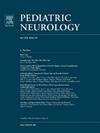Severe Epilepsy in an Individual With a TSC2 R905Q Variant Prompting Late Diagnosis in Affected Family Members
IF 2.1
3区 医学
Q2 CLINICAL NEUROLOGY
引用次数: 0
Abstract
Background
Tuberous sclerosis complex (TSC) is a multisystemic disorder caused by inactivating variants in the mTOR pathway inhibitor genes TSC1 and TSC2. Individuals with TSC are predisposed to benign tumors in multiple organs as well as TSC-associated neuropsychiatric disorders (TAND) and epilepsy. Pathogenic variants in TSC2 are typically associated with a more severe phenotype compared with TSC1; the TSC2 R905Q variant has been shown to be an exception, where patients have been reported to present with unusually mild TSC features that may be undetected.
Methods
We studied the TSC phenotype of a 13-year-old individual and three family members with a TSC2 c.2714G>A (R905Q) pathogenic variant.
Results
Patient 1 presented with severe medically refractory epilepsy without tubers or subependymal nodules and only mild dermatologic features of TSC missed on virtual examinations. Her mother and maternal aunt (Patients 2 and 3–diagnosed after age 50 years) presented with a mild phenotype, with dermatologic features and TAND. Her maternal uncle (Patient 4–diagnosed at age 47 years) displayed the most severe phenotype, presenting with intellectual disability, medically refractory epilepsy, obsessive-compulsive disorder, post-traumatic stress disorder, and psychosis.
Conclusions
This study expands the possible phenotypic spectrum of TSC2 R905Q variant, demonstrating an association with severe epilepsy without associated neuroradiological stigmata. This presentation highlights the possibility of occult focal cortical dysplasia in TSC and emphasizes the importance of genetic testing in individuals with severe epilepsy. Moreover, a late adult diagnosis was subsequently made in other family members allowing for appropriate TSC surveillance to occur.
一名 TSC2 R905Q 变异患者的严重癫痫导致受影响家庭成员的晚期诊断。
背景:结节性硬化症综合征(TSC)是一种多系统疾病,由 mTOR 通路抑制基因 TSC1 和 TSC2 的失活变异引起。TSC患者易患多器官良性肿瘤以及TSC相关神经精神障碍(TAND)和癫痫。与TSC1相比,TSC2的致病变异通常与更严重的表型相关;TSC2 R905Q变异已被证明是一个例外,有报道称患者表现出异常轻微的TSC特征,而这些特征可能未被检测到:方法:我们研究了一名13岁患者和三名家族成员的TSC2 c.2714G>A(R905Q)致病变异的TSC表型:患者 1 患有严重的药物难治性癫痫,无小管或蝶鞍下结节,在虚拟检查中仅发现轻微的 TSC 皮肤特征。她的母亲和姨妈(患者 2 和 3,50 岁后确诊)表现为轻度表型,有皮肤特征和 TAND。她的舅舅(患者4,47岁确诊)的表型最为严重,表现为智力障碍、药物难治性癫痫、强迫症、创伤后应激障碍和精神病:本研究扩展了TSC2 R905Q变异型的可能表型谱,表明该变异型与严重癫痫有关,但没有相关的神经放射学标志。该研究强调了TSC隐匿性局灶性皮质发育不良的可能性,并强调了对严重癫痫患者进行基因检测的重要性。此外,该患者的其他家族成员随后也被确诊为晚期成人患者,因此可以对该患者进行适当的TSC监测。
本文章由计算机程序翻译,如有差异,请以英文原文为准。
求助全文
约1分钟内获得全文
求助全文
来源期刊

Pediatric neurology
医学-临床神经学
CiteScore
4.80
自引率
2.60%
发文量
176
审稿时长
78 days
期刊介绍:
Pediatric Neurology publishes timely peer-reviewed clinical and research articles covering all aspects of the developing nervous system.
Pediatric Neurology features up-to-the-minute publication of the latest advances in the diagnosis, management, and treatment of pediatric neurologic disorders. The journal''s editor, E. Steve Roach, in conjunction with the team of Associate Editors, heads an internationally recognized editorial board, ensuring the most authoritative and extensive coverage of the field. Among the topics covered are: epilepsy, mitochondrial diseases, congenital malformations, chromosomopathies, peripheral neuropathies, perinatal and childhood stroke, cerebral palsy, as well as other diseases affecting the developing nervous system.
 求助内容:
求助内容: 应助结果提醒方式:
应助结果提醒方式:


